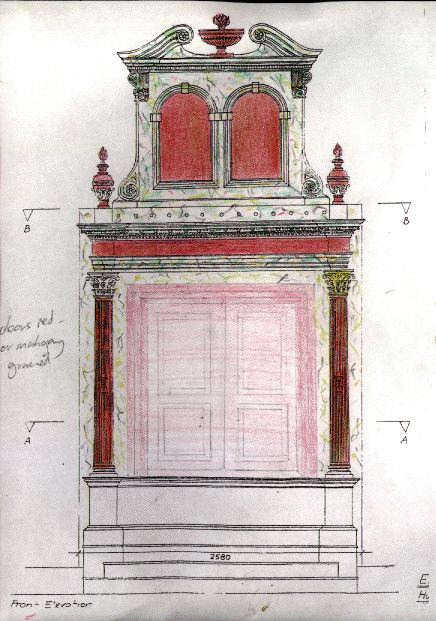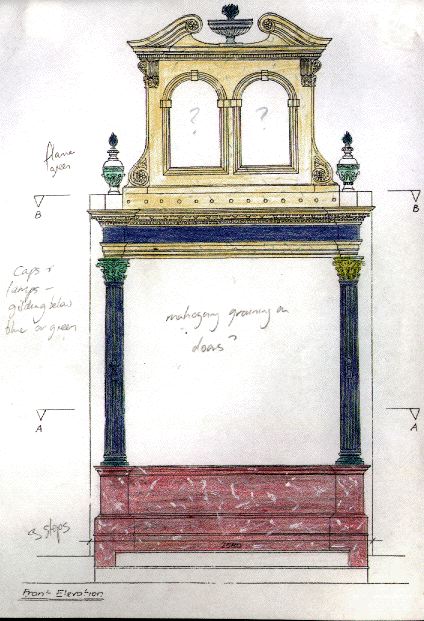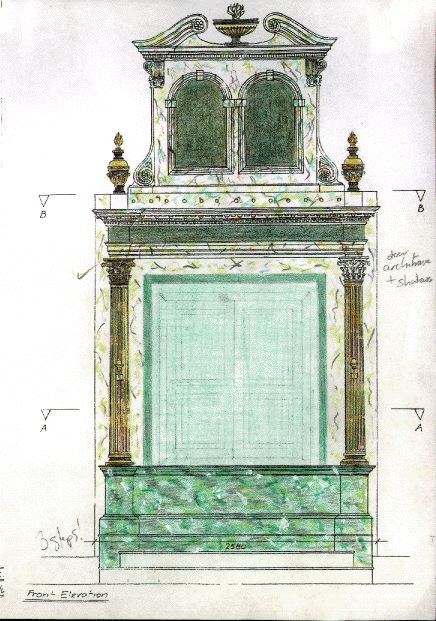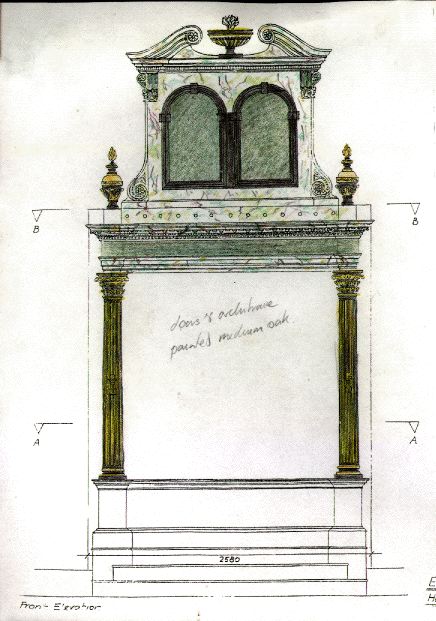|
| ||||
|
|
||||
|
Interim Polychromy Report EXETER SYNAGOGUE: ARK POLYCHROMY INTERIM REPORT INTRODUCTION Some interesting discoveries have been made regarding the polychromy of the Ark, during the cleaning of the upper portions. This report aims to summarise those discoveries in order to provide the basis for discussion as to how to proceed. Following a meeting with Rebecca Child of English Heritage on December 18 1997, it was decided that a detailed investigation should he carried out of some of the more puzzling elements of the upper portions of the Ark, even though this would incur extra costs. Apart from the historical importance of these discoveries, it was crucial to gain further understanding of the paint layers in order to make sense of the cleaning and its implications on the final appearance of the Ark. The cleaning operation involves the removal of a heavily discoloured varnish, which has been liberally applied to all elements of the Ark. Certain features have also been picked out in a heavy black overpaint. The original report of November 1996, recommends partial removal of this unsightly black, but the cleaning tests which accompanied this report were restricted due to limited access. It has now been possible, with the Ark dismantled, to survey the paint more fully. This is discussed in detail below. It is not known when the black overpaint was applied, but it is in place in photographs taken circa 1910. One of the biggest decisions to make regarding the cleaning of the Ark is the extent of removal of this black, and what might he appropriate in terms of final appearance, given the range of possibilities. Whilst close examination of the paint has revealed it to be on the whole in good condition, there are pockets of loose paint that will require fixing, and several areas that will later need filling and retouching. An allowance has been made for this in the section on costs at the end of this report.
POLYCHROMY To date a total of 44 paint samples have been taken, largely from the upper elements. These have been studied in some detail at microscopic level, with particular emphasis on the examination and comparison of cross-sections. Samples are in places extraordinarily complex, with up to 29 layers of paint in evidence. Whilst it would be of interest to carry out analysis of pigments this has been restricted to certain key pigments. The lamps reveal evidence of eight interventions in approximately 200 years, some of which will be full scale redecorations, whilst others a simple retouching. It is not necessary, possible or even practical to gain access to all past interventions as the paint will have received some treatment prior to repainting. What is of great significance is the realisation that the Exeter Ark has had a far richer history than was hitherto realised. Whilst the basic creamy coloured marbling of the 1835 redecoration does not appear significantly different to the earlier scheme, (though it is certainly more exotic), key elements have been singled out for a different treatment. A study of the cross-sections and subsequent windows made in the paint layers, reveals common marker layers that identify particular schemes of decoration, and certain trends. In particular there is the recurrence of a deep rich red colour, applied as a two layer structure. The red itself is a mixed colour consisting of vermilion and ultramarine, combined together to make a rich crimson-red. This layer is glazed with a darker red consisting of the same mixed red with a surface sprinkling of carbon black. Perhaps painted deep red in imitation of porphyry, it does not appear to show any of the characteristic surface 'speckling' associated with porphyry. This red is found on the lamps, the frieze, the columns and the Commandment Boards. 
The Ark Stage II, c.1835? [Please note that this is purely a preliminary sketch] The occurrence of artificial ultramarine is fortuitous as it helps considerably with the dating of this scheme. Discovered in 1828 in France, artificial ultramarine would have been commercially available by the time of the 1835 restoration of the Ark. At this early date its use would have been quite significant in highlighting the status of the Community. It suggests that the Ark was painted according to the latest fashion (although there are later schemes of decoration on the Ark the appearance does not suggest another such lavish restoration, and the indications are that there has not been such wealth in the Community since). 
The Ark Stage I, c.1763? [Please note that this is purely a preliminary sketch] An earlier scheme of blue presents an altogether different appearance, occurring basically on the same elements, as well as the insides of the Ark doors. There is no suggestion that cleaning should involve turning the clock back to this period in the Ark's history, but it represents a still richer appearance. Blue was once the most expensive colour available, and again its use highlights the status of the Community, also at the earlier period. I would like to analyse this blue, but it is unlikely to help with dating, though if it should also contain ultramarine then some re-interpretation will he necessary. The use of blue ties up with the polychromy of the Ark in the Plymouth Synagogue. In between the periods dominated by blue and red some of these features have also been picked out at different times in gold, with up to five schemes in evidence. The removal of the varnish/black reveals a gold on the lamps, the capitals and the columns. However, this most recent application is, upon closer investigation, a very impure, low carat gold paint, that looks more like a bronze paint. Whilst it is likely that the use of this low carat gold was for reasons of economy, there is always the possibility that this sort of bronze finish was chosen to create an antiqued effect. Under the microscope it looks extremely crude and has in places broken down due to its contamination with other metals, in particular copper. The green staining that results from the oxidation of this copper is visible in places to the naked eye, either as spots of green or as a general, unpleasing green tinge When the rest of the Ark is clean, these gilded areas will look particularly neglected, and this is one of the big issues to be discussed and hopefully resolved at the coming meeting. There are two pockets where the bright red vermilion has been found, used in almost pure form, in keeping with earlier paint traditions. There is not enough evidence to explain how such a colour would fit with the other schemes. The capitals present a problem of their own. The black overpaint has here been applied over a thick white gesso. The appearance of the capitals are greatly distorted by the thick build-up of layers which have destroyed the fine quality of the carving. There is much original colour in evidence below this gesso, with gold leaf in the earliest scheme of decoration as well as at two other periods, and green at a later date. This green, which is a mixed green, consists of prussian blue and yellow ochre. Neither of these pigments is any help with dating, but characteristic of both the 18th and 19th centuries. In cross-sections this green can be seen to be glazed or marbled with grey. Whilst it would be possible to retrieve some of this historic colour, most would be lost on the back of the gesso which has shrunk, pulling away the earlier paint and creating air spaces that will in time cause spalling. Here, therefore, it will be necessary to carry out some reconstruction, once a decision has been made as to the most appropriate finish. It is not at all advisable or desirable to add further layers to this mess. The lost form of the carving needs to be rediscovered, and this can only be done by mechanical removal of the black paint and its supporting gesso. 
The Ark Stage III, c.1854? [Please note that this is purely a preliminary sketch] The use of black on the mouldings that frame the Commandment Boards has long been regarded as an eyesore. Unfortunately it was not until after I had cleaned it (not very satisfactorily) that it became obviously incorrect. A study of both the cross-sections and the framing itself revealed that the pale marbling continues underneath the crudely applied black. As no other elements are individually picked out in this manner, tests were carried out to ascertain the visual effects if the black is removed, as well as the condition of the paint below. The marbling is not in perfect condition; it was probably rubbed down prior to repainting, with the black sitting in the roughened surface. However, there is still a vast improvement in appearance once the heavy black has gone, and I would recommend that it is all removed here. 
The Ark Stage IV, c.1915? [Please note that this is purely a preliminary sketch] A harder decision to make on the Commandment Boards is the possibility of returning to an earlier scheme. Beneath the present green background there is the red 'porphyry' which appears to be in good condition and looks as if it belongs with the present pale marbling with its crimson veins. Where fragments of the earlier text have been revealed they appear to be of a superior quality to the present lettering, though it is unclear how well they have survived. The present lettering is rather unattractive, and the gold is uneven and not well applied. One interesting human touch is the surviving thumb print that the gilder left in the gold size.
DOORS Some work has been carried out on the investigation of the Ark doors, though this remains at an early stage. These are at present grained, in imitation of a medium oak. The oak graining has been matched to the discoloured varnish of the marbled surfaces adjacent to the doors. After the marbling has been cleaned, the inappropriate treatment of the doors will he glaringly apparent, and some decision will have to be made as to how to present these doors. The insides of the doors are more important than the outsides in an Ashkenazi synagogue, where the outside of the Ark is covered by a curtain. However, although an investigation of the insides and sides of the doors reveals a rich history of painting, the fronts appear to have been well stripped by the grainer in preparation for painting. It is possible that further evidence for the painting of the door fronts will be found, but an extensive examination of paint samples may prove fruitless. I should like to look further at the Plymouth Ark doors, and a visit to Bevis Marks in London should be considered an obvious point of reference.
DECISIONS The Ark needs to be considered as a whole, and not as a series of separate elements. However, the information obtained from each individual element needs to be assessed, in order to try and get as full a picture as possible. If, logically, it makes sense to take one element back to the 'porphyry' period, then this ought to he followed through elsewhere, where possible. This does however involve a dramatic change in appearance and also some considerable extra expense. There are some places where this is unavoidable; in other places it may be that we leave well alone, though much will have been learnt for posterity.
CAPITALS Capitals, removal of gesso and black. To gild? If so would they be fully gilded or partially? Could these be gilded if other elements are not? If lamps are to be gilded how would they look with gilded capitals?
LAMPS It is not enough here to remove the heavy black overpaint. The gold paint beneath will not sit happily with the surrounding cleaned paintwork. The options are to regild with a higher carat gold leaf, after sealing the present gold paint. Alternatively the gold paint could be removed, and the red 'porphyry' left exposed. If the red is exposed then this has implications for the red elsewhere.
COMMANDMENTS I recommend that the black overpaint on mouldings of Commandments should be removed. If the 'porphyry' colour is to he exposed on the lamps it should be exposed on the texts, where it appears to survive in good condition. It is uncertain, however, how extensively the earlier text will have survived. If the Commandment Boards are to be red again, this would tie in with the crimson veining on the pale marble, and would look better than the present green. If the green is to he kept the gold lettering will need some sensitive retouching.
COLUMNS The gold on the columns looks better than the gold on the lamps, though it is also of a low carat composition. There is evidence of earlier, better quality, gold on the base of the columns, which might suggest that the columns themselves were also gilded previously. Logically if the red is exposed elsewhere it should be uncovered here too, linking the upper and lower portions of the Ark, though this is a huge undertaking. Whilst much invaluable information has been obtained from the current investigation the results remain fragmentary, and it is not possible to gain a complete picture of how the Ark appeared at different times. We can see, for example, that some early stage the columns were blue, and that the capitals were green, but the capitals were gilded in their earliest decoration. The blue columns may well have gone with gilded capitals, but what was the appearance of the columns when the capitals were green? As the investigation goes deeper, so more questions are raised. Many will remain unanswered, though further information will come to light as conservation continues. As far as I know, no study has been made in this country on Jewish polychromy, though it may only reflect the local tradition (which in itself has been much neglected). In view of the extensive loss this century of many historic synagogues throughout Europe, the results of the current investigation of the Exeter Ark polychromy are of particular importance, especially as the Ark is thought to have originated abroad. Even if it was produced here, to quote Edward Jamilly in 'Building Jerusalem: Jewish Architecture in Britain', "the first Ark fronts were undoubtedly taken from foreign models… more typical of Germany and the Low Countries in their Baroque effect than of Renaissance England."
COSTS The original estimated cost for the conservation of the Ark polychromy was £9953, which included £2000 to cover the investigation and conservation/and or repainting of the doors. The extra costs incurred in carrying out the investigation of the more puzzling elements summarised in this report total £1297. The time given by my colleague Ms Judy Wetherall to carry out an investigation of the gilded elements was given free of charge, though travel expenses have been included in the above sum. It is not possible to provide estimates for any additional work that may ensue, until after further debate. Having now worked on some of the upper portions of the Ark, I believe that it is also necessary to allow some extra funding for fixing loose paint and any fillings or re-integration that may also be necessary. It is not possible to know exactly how much of this work will be needed, particularly as the Ark is at present a series of disjointed elements and it is impossible to gauge how much infilling of cracks will he needed when the Ark is re-assembled. If we allow £1000 this should be more than adequate, and it may not all be needed. One final additional cost is due to the discontinuation in this country of one of the main chemical combinations needed for removal of the Ark varnish. I have eventually tracked down a final source of this material (which had been included in my original estimate at a far cheaper price when readily available), for which a further £116 will be required.
February 21 1998
Home | About the Restoration | Holocaust Testimonies | Visit | History | Tour
|




